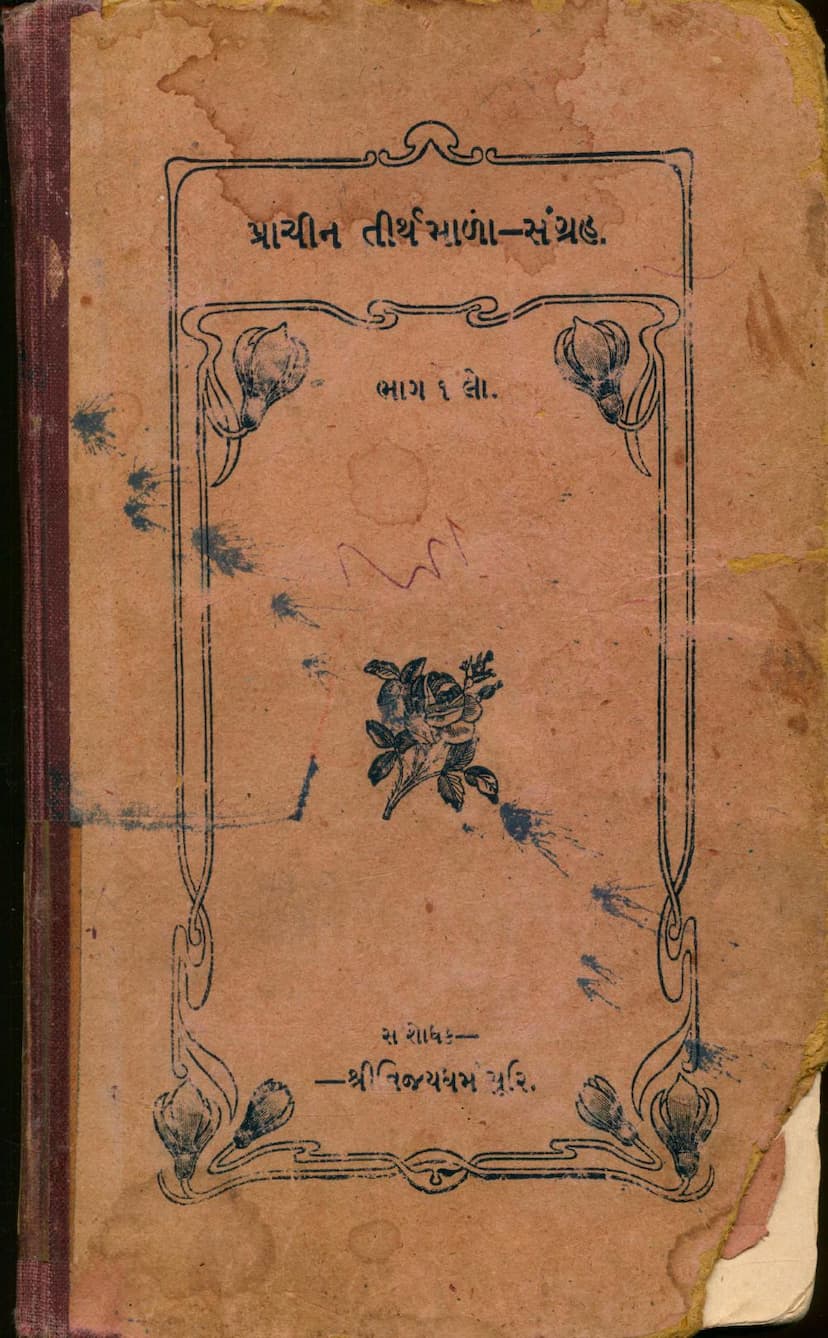Prachin Tirthmala Sangraha Part 01
Added to library: September 2, 2025

Summary
Here's a comprehensive summary of the Jain text "Prachin Tirthmala Sangraha Part 01" by Acharya Shri Vijaydharmasuri:
Book Title: Prachin Tirthmala Sangraha Part 01 (Collection of Ancient Tirthmalas, Part 1) Author: Acharya Shri Vijaydharmasuri Publisher: Yashovijay Jain Granthmala Catalog Link: https://jainqq.org/explore/005681/1
Overall Purpose and Significance:
This book, the first volume in a series, is a compilation of 25 ancient Jain Tirthmalas (poems or chronicles describing pilgrimages and holy sites). Acharya Shri Vijaydharmasuri, a renowned scholar and Jain monk, undertook this project to bring to light historical and religious texts that were previously obscure or neglected. He emphasizes that these Tirthmalas, often overlooked in ancient collections, are invaluable historical documents, providing rich details about ancient cities, customs, rulers, and the state of various regions during different periods. He argues that they are as historically significant, if not more so in some aspects, than other historical texts like Rasa literature that primarily focuses on the lives of Acharyas.
Key Themes and Content:
-
Historical Value of Tirthmalas: The introduction strongly emphasizes that Tirthmalas are crucial for understanding Jain history. They contain descriptions of cities, their locations, the customs of people, the names of kings, and details about the socio-political landscape of ancient India. This contrasts with modern pilgrimage descriptions that might focus more on devotional aspects rather than historical details.
-
Preservation of Ancient Language and Literature: The author decided to retain the original language of the Tirthmalas to allow readers to understand the writing styles and languages of different historical periods.
-
Categorization of Tirthmalas: To avoid repetition and present the information systematically, the 25 Tirthmalas are divided into five categories:
- Purva Deshiya Tirtho (Eastern Regions): This section includes five Tirthmalas focusing on pilgrimage sites in the East.
- Siddhachal Tirth Sambandhi (Relating to Siddhachal/Shatrunjay Tirth): This category contains eight Tirthmalas dedicated to the highly revered Shatrunjay hill.
- Gujarat, Kathiawad, Marwar, Mewar, and Dakshin Ke Tirtho (Western and Southern Regions): This section comprises five Tirthmalas covering holy sites in these regions.
- Parshvanath Ke Tirtho (Tirths of Lord Parshvanath): Four Tirthmalas specifically dedicated to the pilgrimage sites associated with Lord Parshvanath.
- Parchuran Vibhag (Miscellaneous Section): This includes six Tirthmalas that describe single temples, eternal holy sites, or other miscellaneous pilgrimage descriptions, such as those related to Surat, Jesalmer, and Kavi.
-
Detailed Analysis within Categories: For each category, the author provides a brief introduction to the included Tirthmalas, mentioning their authors and estimated time of composition. He then delves into specific details from these Tirthmalas, comparing the descriptions of key sites, highlighting variations in accounts, and offering his own research and opinions on the accurate locations of ancient places. For instance, he discusses the identification of Koshambi, Prayag, Varanasi, Kshetrigund, and Sampetshikhar, cross-referencing textual evidence with geographical findings.
-
Correction of Historical Inaccuracies: The author demonstrates his scholarly approach by correcting potential inaccuracies found in the original texts, such as discrepancies in dates or locations, based on his research and understanding of Jain scriptures and history. He notes the importance of examining the context and potential errors in ancient writings.
-
Contribution to Jain Historiography: Shri Vijaydharmasuri expresses hope that this collection will shed significant light on Jain history and encourage other historians and enthusiasts to pursue similar research, especially in uncovering more Tirthmalas in Sanskrit and Prakrit.
-
Acknowledgements: The author expresses gratitude to various individuals and institutions for their help in collecting and publishing these manuscripts, including the custodians of the Kishangarh treasury, Yatishri Premsuriji of Ajmer, the administration of Palitana, Yatishri Saubhagya Vijayji of Lunawa, Pt. Chandradhar Guleri, and the management of Messrs. Dosabhai Abhechand of Bhavnagar.
Examples of Detailed Analysis (as seen in the provided pages):
- Koshambi: The author discusses multiple theories about the location of ancient Koshambi and, through textual analysis, supports the identification with Kosam Khiraj and Kosam Inam near the Yamuna river.
- Prayag (Allahabad): He examines the different reasons cited in various Tirthmalas for its sanctity (e.g., initiation of Adinath, feeding, completion of penance) and clarifies that Adinath attained Kevala Gnyan (omniscience) under an Ashoka tree, and performed his first parana (breaking of fast) in Hastinapur. The sanctity of Prayag is attributed to Adinath's Kevala Gnyan under a Vata tree.
- Kashi (Varanasi): The text discusses the four kalyanakas (auspicious events) of Suparshvanath and Parshvanath that occurred here, making it a sacred Jain site.
- Siddhachal (Shatrunjay): The collection includes eight Tirthmalas dedicated to this paramount pilgrimage site, detailing its various temples, sites of veneration, and historical renovations by patrons like Samara Shah and Karma Shah.
- Sammeta Shikhar: The Tirthmalas here discuss the journey of pilgrims, the local rulers, and the descriptions of the mountain's flora and fauna.
- Parshvanath's Tirths: The compilation lists 108 sacred sites associated with Lord Parshvanath, highlighting their geographical distribution across Gujarat, Kathiawad, and Marwar.
In essence, "Prachin Tirthmala Sangraha Part 01" is a scholarly endeavor to preserve and make accessible a rich corpus of Jain literature that serves as a vital source for understanding the history, geography, and devotional practices of Jainism. It provides detailed, comparative analyses of these ancient texts, contributing significantly to the field of Jain historiography.